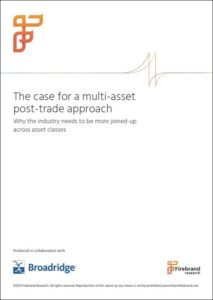Why multi-asset post-trade now?
The diversification of institutional investments into a broader range of asset types over the last couple of decades has been significant and transformative. Buy-side firms have expanded their investment focuses from the more traditional end of the investment spectrum to all kinds of alternatives, including real assets such as commodities, real estate and even crypto assets in some cases, in the search for yield. They have also expanded their use of the more esoteric fixed income and derivatives in a bid to garner greater returns as passive investment vehicles continue their growth in popularity among pension fund clients. Active asset management in today’s markets also necessitates more active hedging activities, especially given the volatility experienced over the last 18 months.
The impact on the sell-side
This buy-side demand for support across a broader range of asset classes has therefore placed increased pressure on their sell-side counterparts to meet these requirements. The complexity of dealing with this demand from a large variety of buy-side clients during the pandemic, when markets experienced significant volatility and volume increases, had a knock-on effect on settlement failures. The pressure to support a broader range of asset classes, and high volumes in some of the traditional asset classes, have combined to significantly squeeze sell-side firms’ post-trade operations and IT teams.
Based on capital markets research specialist, Firebrand’s survey, most sell-side firms have siloed infrastructures to process the range of asset classes their clients and trading activities require. They have separate middle and back-office operations and technologies for dealing with equities, fixed income and derivatives, for example, because of the product-siloed manner in which most of these firms have operated up until this point. Regional regulatory and market practice divergence at the global level has accentuated the issue by adding regional silos into the mix, which has increased duplication of effort and cost. Post-trade processing inefficiency has been compounded by these legacy, silo-based infrastructures that have struggled to keep up with modern market requirements.
This extract from a Special Report entitled ‘The case for a multi-asset post-trade approach’ is written by Firebrand, sponsored by Broadridge.




Leave a Reply
You must be logged in to post a comment.